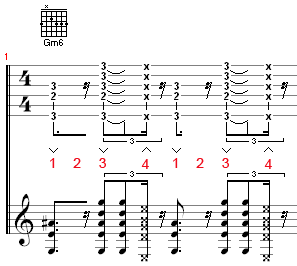The pompe
Introduction
Manouche style requires accompanying rhythm guitar players to highlight the solist's musicality. Rhythm guitar in Manouche style is called la pompe. It is of paramount importance that in order for a pompe to sound Manouche, it is played with a swing accent. To cut a long story short, the accompanying guitar is supposed to replace the drumkit and therefore it tries in some way to mimic its accents, notably what's played at the charleston.
The pompe is the first thing that is taught when starting Manouche style. Manouches themselves say that several years are needed to master the pompe before tackling the solo parts. As far as I'm concerned, I'm learning both at the same time but it's up to everyone to follow the tradition or not. In any case, the pompist - as we can call him - must always adapt his volume so that whatever the solist plays, it can be heard clearly, therefore not too loud when the chorus is quiet, and louder when it gets stronger. Here are a few films to explain the different pompes available on the market (at least the ones I know of).
Standard pompe
Pompe's movement can be broken up into four swinged beats.
- Downstroke on the three lower strings
- Right hand goes back up without touching the strings
- Downstroke on all strings
- Upstroke on all strings while the left hand mutes them
The strings are muted by the left hand at the end of beats 1 and 3, which means the pressure on the strings by the left hand is released. The right hand roughly does the same movement as if trying to strike a match.
According to whether the fourth beat is swinged or not, the pompe will be called swinged or straight.
| Swinged | Straight |
breaking down the pompe
Right hand view to see the different stages of the movement
Exercise to mute the strings
Muting the strings is important for the pompe, because it is this very movement that allows proportioning between the harmonic side (let ring the chord notes) and the percussive side (do a big tchac with the strings). The more we let ring, the more it's harmonic, the less it's percussive. Conversely, the faster we mute the string, the less it's harmonic, the more it's percussive.
See also: typical accompanying rhythm guitar in different styles





